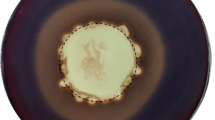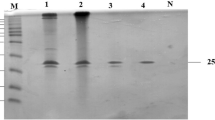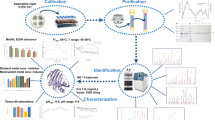Abstract
We have identified a highly pH-adaptable and stable xylanase (XynA4) from the thermoacidophilic Alicyclobacillus sp. A4, a strain that was isolated from a hot spring in Yunnan Province, China. The gene (xynA4) that encodes this xylanase was cloned, sequenced, and expressed in Escherichia coli. It encodes a 338-residue polypeptide with a calculated molecular mass of 42.5 kDa. The deduced amino acid sequence is most similar to (53% identity) an endo-1,4-β-xylanase from Geobacillus stearothermophilus that belongs to family 10 of the glycoside hydrolases. Purified recombinant XynA4 exhibited maximum activity at 55°C and pH 7.0, had broad pH adaptability (>40% activity at pH 3.8–9.4) and stability (retaining >80% activity after incubation at pH 2.6–12.0 for 1 h at 37°C), and was highly thermostable (retaining >90% activity after incubation at 60°C for 1 h at pH 7.0). These properties make XynA4 promising for application in the paper industry. This is the first report that describes cloning and expression of a xylanase gene from the genus Alicyclobacillus.



Similar content being viewed by others
References
Biely P, Mislovicová D, Toman R (1985) Soluble chromogenic substrates for the assay of endo-1,4-beta-xylanases and endo-1,4-beta-glucanases. Anal Biochem 114:142–146
Morosoli R, Durand S, Moreau A (1992) Cloning and expression in Escherichia coli of a xylanase-encoding gene from the yeast Cryptococcus albidus. Gene 117:145–150
Chang P, Tsai WS, Tsai CL, Tseng MJ (2004) Cloning and characterization of two thermostable xylanases from an alkaliphilic Bacillus firmus. Biochem Biophys Res Commun 319:1017–1025. doi:10.1016/j.bbrc.2004.05.078
Sharma M, Chadha BS, Kaur M, Ghatora SK, Saini HS (2008) Molecular characterization of multiple xylanase producing thermophilic/thermotolerant fungi isolated from composting materials. Lett Appl Microbiol 46:526–535. doi:10.1111/j.1472-765X.2008.02357.x
Collins T, Gerday C, Feller G (2005) Xylanases, xylanase families and extremophilic xylanases. FEMS Microbiol Rev 29:3–23. doi:10.1016/j.femsre.2004.06.005
Inborr J, Puhakka J, Bakker JG, van der Meulen J (1999) Beta-glucanase and xylanase activities in stomach and ileum of growing pigs fed wheat bran based diets with and without enzyme treatment. Arch Tierernahr 52:263–274
Zheng W, Schingoethe DJ, Stegeman GA, Hippen AR, Treachert RJ (2000) Determination of when during the lactation cycle to start feeding a cellulase and xylanase enzyme mixture to dairy cows. J Dairy Sci 83:2319–2325
Gao F, Jiang Y, Zhou GH, Han ZK (2007) The effects of xylanase supplementation on growth, digestion, circulating hormone and metabolite levels, immunity and gut microflora in cockerels fed on wheat-based diets. Br Poult Sci 48:480–488. doi:10.1080/00071660701477320
Jiang ZQ, Yang SQ, Tan SS, Li LT, Li XT (2005) Characterization of a xylanase from the newly isolated thermophilic Thermomyces lanuginosus CAU44 and its application in bread making. Lett Appl Microbiol 41:69–76. doi:10.1111/j.1472-765X.2005.01725.x
Savitha S, Sadhasivam S, Swaminathan K (2007) Application of Aspergillus fumigatus xylanase for quality improvement of waste paper pulp. Bull Environ Contam Toxicol 78:217–221. doi:10.1007/s00128-007-9132-8
Roncero MB, Torres AL, Colom JF, Vidal T (2003) TCF bleaching of wheat straw pulp using ozone and xylanase. Part A: paper quality assessment. Bioresour Technol 87:305–314
Damaso MC, de Castro AM, Castro RM, Andrade CM, Pereira N Jr (2004) Application of xylanase from Thermomyces lanuginosus IOC-4145 for enzymatic hydrolysis of corncob and sugarcane bagasse. Appl Biochem Biotechnol 116:1003–1012
Tabernero C, Sánchez-Torres J, Pérez P, Santamaría RI (1995) Cloning and DNA sequencing of xyaA, a gene encoding an endo-beta-1,4-xylanase from an alkalophilic Bacillus strain (N137). Appl Environ Microbiol 61:2420–2424
Gessesse A (1998) Purification and properties of two thermostable alkaline xylanases from an alkaliphilic Bacillus sp. Appl Environ Microbiol 64:3533–3535
Kimura T, Ito J, Kawano A, Makino T, Kondo H, Karita S, Sakka K, Ohmiya K (2000) Purification, characterization, and molecular cloning of acidophilic xylanase from Penicillium sp. 40. Biosci Biotechnol Biochem 64:1230–1237
Wood PJ, Erfle JD, Teather RM (1998) Use of complex formation between Congo red and polysaccharide in detection and assay of polysaccharide hydrolase. Methods Enzymol 160:59–74
Thompson JD, Higgins DG, Gibson TJ (1994) CLUSTAL W: improving the sensitivity of progressive multiple sequence alignment through sequence weighting, position-specific gap penalties and weight matrix choice. Nucleic Acids Res 22:4673–4680
Baba T, Shinke R, Nanmori T (1994) Identification and characterization of clustered genes for thermostable xylan-degrading enzymes, beta-xylosidase and xylanase, of Bacillus stearothermophilus 21. Appl Environ Microbiol 60:2252–2258
Liu YG, Whittier RF (1995) Thermal asymmetric interlaced PCR: automatable amplification and sequencing of insert end fragments from P1 and YAC clones for chromosome walking. Genomics 25:674–681
Zhang K, Wang G, Zou Z, Jia X, Wang S, Lin P, Chen Y, Zhang Z, Wang Y (2008) Cloning, characterization and TBT exposure response of CuZn superoxide dismutase from Haliotis diversicolor supertexta. Mol Biol Rep 36:583–594. doi:10.1007/s11033-008-9217-4
Arnold K, Bordoli L, Kopp J, Schwede T (2006) The SWISS-MODEL workspace: a web-based environment for protein structure homology modeling. Bioinformatics 22:195–201. doi:10.1093/bioinformatics/bti770
Bradford MM (1976) A rapid and sensitive method for the quantitation of microgram quantities of protein utilizing the principle of protein-dye binding. Anal Biochem 72:248–254
Laemmli UK (1970) Cleavage of structural proteins during the assembly of the head of bacteriophage T4. Nature 227:680–685
Miller GL (1959) Use of dinitrosalicylic acid reagent for determination of reducing sugar. Anal Chem 31:426–428
Liu W, Shi P, Chen Q, Yang P, Wang G, Wang Y, Luo H, Yao B (2009) Gene cloning, overexpression, and characterization of a xylanase from Penicillium sp. CGMCC 1669. Appl Biochem Biotechnol. doi:10.1007/s12010-009-8719-4
Lineweaver H, Burk D (1934) The determination of enzyme dissociation constants. J Am Chem Soc 56:658–666
Li N, Meng K, Wang Y, Shi P, Luo H, Bai Y, Yang P, Yao B (2008) Cloning, expression, and characterization of a new xylanase with broad temperature adaptability from Streptomyces sp. S9. Appl Microbiol Biotechnol 80:231–240. doi:10.1007/s00253-008-1533-z
Gat O, Lapidot A, Alchanati I, Regueros C, Shoham Y (1994) Cloning and DNA sequence of the gene coding for Bacillus stearothermophilus T-6 xylanase. Appl Environ Microbiol 60:1889–1896
Wu S, Liu B, Zhang X (2006) Characterization of a recombinant thermostable xylanase from deep-sea thermophilic Geobacillus sp. MT-1 in East Pacific. Appl Microbiol Biotechnol 72:1210–1216. doi:10.1007/s00253-006-0416-4
Solomon V, Teplitsky A, Shulami S, Zolotnitsky G, Shoham Y, Shoham G (2007) Structure-specificity relationships of an intracellular xylanase from Geobacillus stearothermophilus. Acta Crystallogr D Biol Crystallogr 63:845–859. doi:10.1107/S0907444907024845
Wisotzkey JD, Jurtshuk P Jr, Fox GE, Deinhard G, Poralla K (1992) Comparative sequence analyses on the 16S rRNA (rDNA) of Bacillus acidocaldarius, Bacillus acidoterrestris, and Bacillus cycloheptanicus and proposal for creation of a new genus, Alicyclobacillus gen. nov. Int J Syst Bacteriol 42:263–269
Darland G, Brock TD, Samsonoff W, Conti SF (1970) A thermophilic, acidophilic mycoplasma isolated from a coal refuse pile. Science 170:1416–1418
Herrmann A, Schlösser A, Schmid R, Schneider E (1996) Biochemical identification of a lipoprotein with maltose-binding activity in the thermoacidophilic Gram-positive bacterium Alicyclobacillus acidocaldarius. Res Microbiol 147:733–737
Albuquerque L, Rainey FA, Chung AP, Sunna A, Nobre MF, Grote R, Antranikian G, da Costa MS (2000) Alicyclobacillus hesperidum sp. nov. and a related genomic species from solfataric soils of Sao Miguel in the Azores. Int J Syst Evol Microbiol 50:451–457
Goto K, Tanimoto Y, Tamura T, Mochida K, Arai D, Asahara M, Suzuki M, Tanaka H, Inagaki K (2002) Identification of thermoacidophilic bacteria and a new Alicyclobacillus genomic species isolated from acidic environments in Japan. Extremophiles 6:333–340
Matsubara H, Goto K, Matsumura T, Mochida K, Iwaki M, Niwa M, Yamasato K (2002) Alicyclobacillus acidiphilus sp. nov., a novel thermo-acidophilic, omega-alicyclic fatty acid-containing bacterium isolated from acidic beverages. Int J Syst Evol Microbiol 52:1681–1685
Groenewald WH, Gouws PA, Witthuhn RC (2009) Isolation, identification and typification of Alicyclobacillus acidoterrestris and Alicyclobacillus acidocaldarius strains from orchard soil and the fruit processing environment in South Africa. Food Microbiol 26:71–76. doi:10.1016/j.fm.2008.07.008
Li N, Shi P, Yang P, Wang Y, Luo H, Bai Y, Zhou Z, Yao B (2009) A xylanase with high pH stability from Streptomyces sp. S27 and its carbohydrate-binding module with/without linker-region-truncated versions. Appl Microbiol Biotechnol 83:99–107. doi:10.1007/s00253-008-1810-x
Inagaki K, Nakahira K, Mukai K, Tamura T, Tanaka H (1998) Gene cloning and characterization of an acidic xylanase from Acidobacterium capsulatum. Biosci Biotechnol Biochem 62:1061–1067
Nakamura S, Wakabayashi K, Nakai R, Aono R, Horikoshi K (1993) Purification and some properties of an alkaline xylanase from alkaliphilic Bacillus sp. strain 41M–1. Appl Environ Microbiol 59:2311–2316
Bajpai P (1999) Application of enzymes in the pulp and paper industry. Biotechnol Progress 15:147–157
Georis J, Giannotta F, de Buyl E, Granier B, Frère JM (2000) Purification and properties of three endo-β-1,4-xylanases produced by Streptomyces sp. strain S38 which diver in their ability to enhance the bleaching of kraft pulps. Enzyme Microb Technol 26:178–186
Ahlawat S, Battan B, Dhiman SS, Sharma J, Mandhan RP (2007) Production of thermostable pectinase and xylanase for their potential application in bleaching of kraft pulp. J Ind Microbiol Biotechnol 34:763–770. doi:10.1007/s10295-007-0251-3
Khandeparkar R, Bhosle NB (2007) Application of thermoalkalophilic xylanase from Arthrobacter sp. MTCC 5214 in biobleaching of kraft pulp. Bioresour Technol 98:897–903. doi:10.1016/j.biortech.2006.02.037
Acknowledgments
This work was supported by the National High Technology Research and Development Program of China (863 Program; No. 2007AA100601) and the National Key Technology Program of China (No. 2006BAD12B05-03).
Author information
Authors and Affiliations
Corresponding author
Rights and permissions
About this article
Cite this article
Bai, Y., Wang, J., Zhang, Z. et al. A new xylanase from thermoacidophilic Alicyclobacillus sp. A4 with broad-range pH activity and pH stability. J Ind Microbiol Biotechnol 37, 187–194 (2010). https://doi.org/10.1007/s10295-009-0662-4
Received:
Accepted:
Published:
Issue Date:
DOI: https://doi.org/10.1007/s10295-009-0662-4




